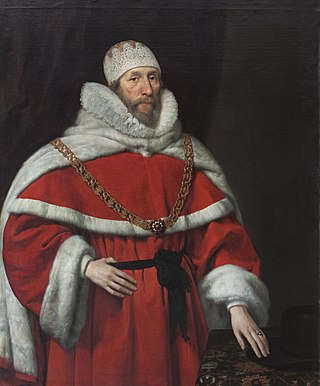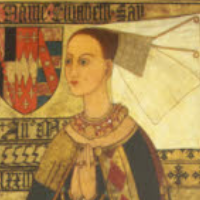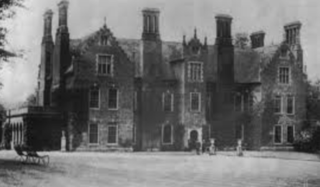Related Research Articles

Thomas Howard, 1st Earl of Suffolk, of Audley End House in the parish of Saffron Walden in Essex, and of Suffolk House near Westminster, a member of the House of Howard, was the second son of Thomas Howard, 4th Duke of Norfolk by his second wife Margaret Audley, the daughter and eventual sole heiress of Thomas Audley, 1st Baron Audley of Walden, of Audley End.

Sir Thomas Erpingham was an English soldier and administrator who loyally served three generations of the House of Lancaster, including Henry IV and Henry V, and whose military career spanned four decades. After the Lancastrian usurpation of the English throne in 1399, his career in their service was transformed as he rose to national prominence, and through his access to royal patronage he acquired great wealth and influence.

Sir Richard Southwell PC was an English Privy Councillor.

Sir Clement Higham, or Heigham, of Barrow, Suffolk, was an English lawyer and politician, a Speaker of the House of Commons in 1554, and Chief Baron of the Exchequer in 1558–1559. A loyal Roman Catholic, he held various offices and commissions under Queen Mary, and was knighted in 1555 by King Philip, but withdrew from politics after the succession of Queen Elizabeth I in 1558.
The Eastern Association of counties was an administrative organisation set up by Parliament in the early years of the First English Civil War. Its main function was to finance and support an army which became a mainstay of the Parliamentarian military effort until early 1645. In January 1644 committeemen of the Eastern Association gathered at the Bury Conference to discuss their concerns as regards the proposed New Model Army. However in the following months many of its units were incorporated into this new military formation.

Sir Henry Hobart, 1st Baronet, of Blickling Hall, was an English politician who succeeded Sir Edward Coke to become Chief Justice of the Court of Common Pleas.

Sir Thomas Richardson of Honingham in Norfolk, was an English judge and politician who sat in the House of Commons from 1621 to 1622. He was Speaker of the House of Commons for this parliament. He was later Chief Justice of the Common Pleas and Chief Justice of the King's Bench.
The high sheriff is the oldest secular office under the Crown and is appointed annually by the Crown. The High Sheriff of Norfolk was originally the principal law enforcement officer in Norfolk and presided at the assizes and other important county meetings. Most of the responsibilities associated with the post have been transferred elsewhere or are now defunct, so that its functions are now largely ceremonial. There was a single high sheriff serving the two counties of Norfolk and Suffolk until 1576.
This is a list of Sheriffs of Norfolk and Suffolk. The Sheriff is the oldest secular office under the Crown and is appointed annually by the Crown. He was originally the principal law enforcement officer in the county and presided at the Assizes and other important county meetings. After 1576 there was a separate Sheriff of Norfolk and Sheriff of Suffolk.
Sir William Boleyn, KB of Blickling Hall in Norfolk and Hever Castle in Kent, was a wealthy and powerful landowner who served as Sheriff of Kent in 1489 and as Sheriff of Norfolk and Suffolk in 1500. He was the father of Thomas Boleyn, 1st Earl of Wiltshire, whose daughter was Queen Anne Boleyn, the second wife of King Henry VIII.

Sir Robert Bacon, 3rd Baronet of Redgrave (1574–1655) was an English landowner.

Elizabeth Cheney was a member of the English gentry, who, by her two marriages, was the great-grandmother of Anne Boleyn, Jane Seymour, and Catherine Howard, three of the wives of King Henry VIII of England, thus making her great-great-grandmother to King Edward VI, the son of Henry VIII and Jane Seymour, and Elizabeth I, the daughter of Henry VIII and Anne Boleyn. Her first husband was Sir Frederick Tilney, and her second husband was Sir John Say, Speaker of the House of Commons. She bore a total of eight children from both marriages.
Thomas Fowle was a Church of England clergyman, Fellow of St John's College, Cambridge, rector of Redgrave and Hinderclay, Suffolk, and prebendary of Norwich Cathedral.
Sir John Sulyard, of Wetherden and Haughley, Suffolk, was a prominent East Anglian magistrate, landowner, High Sheriff, knight and standard-bearer, strongly Roman Catholic in religious affiliation, who sat in parliament during the reign of Queen Mary.
Thomas Gawdy, of Shotesham and Redenhall, Norfolk, was Serjeant-at-law, an English barrister, Recorder, and member of parliament.

Sir William Drury was an English landowner and member of parliament. He was the father of Sir Robert Drury, patron of the poet John Donne.

Spixworth Hall was an Elizabethan country house in the civil parish of Spixworth in Norfolk, located just north of the city of Norwich on the Buxton Road. It was demolished in 1952.

Bayfield Hall is a Grade II* listed building which stands in a small estate close to the village of Letheringsett and the hamlet of Glandford in the English county of Norfolk within the United Kingdom. The house that stands today was built in the last part of the 18 century replacing an earlier manor house thought to have been built in the 16 century. That house had been constructed of an early medieval manor house.
Sir Arthur Hopton of Cockfield Hall in Yoxford, Suffolk was an English knight, landowner, magistrate, and Member of Parliament.
Thomas Thursby (1487–1543) of Ashwicken was a notorious land encloser in Norfolk in the 1510s–1540s.
References
- ↑ Kingston, Alfred (1897). East Anglia and the Great Civil War. London: Elliot Stock.
- ↑ Everitt, Alan (1960). Suffolk and the Great Rebellion, 1640-1660 (PDF). Ipswich: Suffolk Records Society.
- ↑ Jermy, Kenneth E. (1993). "Colonel Robert Jermy, M.P". Norfolk Ancestor. 6 (10): 328-334.
- ↑ Greenwood, Isaac John (1934). The Greenwood Family of Norwich, England in America (PDF). Concord, New Hampshire: Rumford Press.